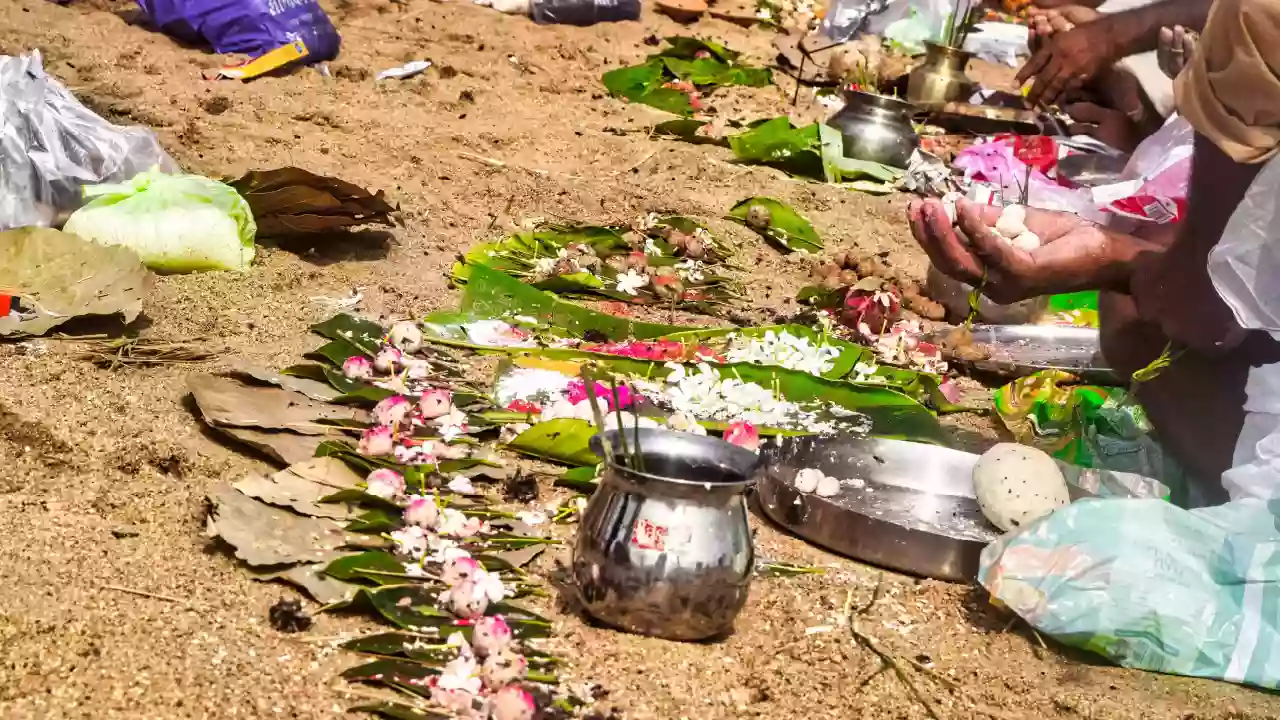ॐ श्री गुरवे नमः | ॐ नित्यकर्मणे नमः | ॐ पितृकार्य तत्पराय नमः |
Namaste,
Pitrupaksha and Nitya Karma: How the Special Ancestral Fortnight Differs From Daily Devotion

The Steady Stream: Understanding Daily Devotion (Nitya Karma – नित्य कर्म)
Before we highlight the uniqueness of Pitrupaksha, let us first honour the importance of Nitya Karma – the daily duties and devotions prescribed in our Dharma. These are the foundational practices that sustain our spiritual well-being day in and day out.
- What it Includes: Nitya Karma typically encompasses:
- Morning Ablutions & Prayers: Bathing, Sandhyavandanam (prayers at junctions of the day – sunrise, noon, sunset), Japa (mantra repetition).
- Deity Worship (Deva Puja): Offering prayers, flowers, incense, light (diya), and food (naivedya) to one’s Ishta Devata (chosen deity) or family deities at the home altar.
- Scriptural Study (Swadhyaya): Reading or listening to sacred texts.
- Offering Water (Tarpan): Some traditions include simple daily Tarpan to Devas, Rishis, and sometimes Pitrus as part of Sandhyavandanam or morning rituals.
- Acts of Charity (Daana): Small, regular acts of giving.
- Pancha Maha Yajna: The five great daily sacrifices (often performed symbolically) include Brahma Yajna (study/teaching Vedas), Deva Yajna (offerings to Gods), Pitru Yajna (offerings to ancestors, often simple water or food), Bhuta Yajna (feeding beings), and Manushya Yajna (feeding guests/needy humans).
- Purpose of Nitya Karma:
- To maintain spiritual purity and discipline.
- To express ongoing gratitude to the divine forces and lineage.
- To foster a continuous connection with the sacred.
- To counteract negative karmic influences accumulated daily.
- To cultivate Sattva Guna (quality of purity, harmony).
- Ancestors in Daily Practice: As seen in Pitru Yajna and sometimes daily Tarpan, ancestors are acknowledged in Nitya Karma. A brief remembrance, offering a portion of food mentally before eating, or a simple water offering can be part of the daily routine for many. It’s a gentle, continuous thread of connection.
Nitya Karma is like the steady, daily nourishment that keeps the body and soul healthy. It’s consistent, broad, and essential for overall spiritual sustenance.
The Sacred Reservoir: Understanding Pitrupaksha (पितृपक्ष)

Now, let us turn to Pitrupaksha. If Nitya Karma is the daily meal, Pitrupaksha is the annual grand feast, meticulously prepared and offered with focused intention.
- Recap: As we’ve discussed, Pitrupaksha is a specific 15-16 day period (Krishna Paksha of Ashwin month, during Dakshinayana) dedicated exclusively to honouring departed ancestors (Pitrus).
- Core Activities: It involves specific, often more elaborate rituals like Shraddha (detailed offerings with Pindas), Tarpan (water offerings with sesame seeds), Brahman Bhojan (feeding Brahmins), and acts of charity done specifically in the name of ancestors.
- Purpose: To intensely express gratitude, fulfill the sacred duty of Pitru Rina, provide focused sustenance and peace to ancestors believed to be visiting Earth, seek their concentrated blessings, and address potential Pitra Dosha (ancestral afflictions).
Pitrupaksha is like a dedicated pilgrimage or a major sacred ceremony – specific in time, focused in intent, intense in energy, and yielding unique results.
What Makes Pitrupaksha So Special? Key Differences Unveiled

Why is this period elevated above daily remembrance?
- Exclusive Focus & Intensity (एकाग्रता – Ekāgratā):
- Daily: Ancestors are usually one part of a broader devotional routine that includes Devas, Gurus, scriptures, etc. The focus is diffused.
- Pitrupaksha: This entire fortnight is singularly dedicated to the Pitrus. All spiritual energy, thoughts, actions, and resources are channelled towards them. This concentrated focus is believed to create a powerful energetic connection. Think of the difference between a general-purpose lamp and a focused spotlight.
- Specific Cosmic Timing (काल विशेष – Kāla Viśeṣa):
- Daily: Daily rituals align with the diurnal cycle (sunrise, noon, sunset).
- Pitrupaksha: As we discussed, this period occurs during a specific astronomical window – Dakshinayana (Sun’s southern path, linked to Pitru Loka), Sun in Kanya Rashi, and Krishna Paksha (waning moon, conducive to ancestral connection). Our Rishis identified this confluence as uniquely potent for Pitru-karya (ancestral rites). The very fabric of time is considered different, more receptive to these specific frequencies.
- Belief in Ancestral Presence (पितृ आगमन – Pitṛ Āgamana):
- Daily: We believe ancestors offer blessings from their realm.
- Pitrupaksha: There’s a strong traditional belief, supported by scriptures like the Garuda Purana, that Lord Yama grants special permission for the Pitrus to leave Pitru Loka and visit their descendants on Earth during this fortnight. They are believed to be physically (in subtle form) closer, residing near their family homes, eagerly anticipating offerings. This belief imbues the rituals with greater immediacy and significance. Offerings are made with the conviction that the recipients are present.
- Prescribed Ritual Depth (विशिष्ट कर्मकाण्ड – Viśiṣṭa Karmakāṇḍa):
- Daily: Rituals involving ancestors are often simpler – a brief water offering (Tarpan without elaborate setup), a mental offering of food.
- Pitrupaksha: This period involves specific, detailed rituals like Shraddha (requiring specific procedures, mantras, materials like Kusha grass, sesame seeds, Pinda Daan) and often Brahman Bhojan. These rituals are designed to provide specific types of sustenance (like the Pindas representing the subtle body) and satisfaction (Tripti) that simple daily remembrance might not fully accomplish. These are considered the most effective means prescribed by Shastras for nourishing the Pitrus.
- Addressing Pitru Rina & Pitra Dosha (ऋण मुक्ति / दोष निवारण – Rṇa Mukti / Doṣa Nivāraṇa):
- Daily: Helps maintain a positive connection and general well-being.
- Pitrupaksha: This is considered the prime time for specifically addressing the Pitru Rina (ancestral debt). The performance of Shraddha is seen as the most direct way to fulfill this obligation. Furthermore, if a family is experiencing issues believed to stem from Pitra Dosha<span style=”font-weight: 400;”> (afflictions due to dissatisfied ancestors or their past karma), the rituals performed during Pitrupaksha are the most potent remedies prescribed.
- Heightened Sensitivity & Receptivity (ग्राहकता – Grāhakatā):
- Daily: Performed within the normal flow of worldly life.
- Pitrupaksha: The concentrated focus, the belief in ancestral presence, and the specific timing create an atmosphere of heightened spiritual sensitivity. Both the performers and, it is believed, the ancestors are more receptive during this time. The veil between worlds is thinner, making the exchange of energy (offerings going up, blessings coming down) more direct and impactful.
- Atmosphere of Austerity and Respect (संयम / आदर – Saṃyama / Ādara):
- Daily: Integrated into regular life.
- Pitrupaksha: The period carries a specific ethos. The avoidance of auspicious events, dietary restrictions (simple Satvik food, avoiding certain ingredients), refraining from haircuts or new purchases – these create an atmosphere of austerity (Samyama) and focused respect (Adara). This collective shift in lifestyle during the fortnight further amplifies the spiritual energy directed towards the ancestors.
An Analogy: Daily Visit vs. Annual Pilgrimage
Think of it like this,
- Daily Devotion: Is like visiting the local temple near your home every day. It maintains a consistent connection, offers peace, and is a vital part of life. You offer a quick prayer, perhaps light a lamp.
- Pitrupaksha: Is like undertaking an annual pilgrimage to a major, highly sacred shrine (like Kashi, Prayag, Gaya, or Badrinath) specifically dedicated to a particular aspect of the divine or, in this case, the ancestors.
- You prepare specially for the journey (the austerities).
- You travel during an auspicious time.
- You perform specific, detailed rituals prescribed for that holy site (Shraddha, Pinda Daan).
- You go with a focused intention (honouring ancestors, fulfilling Pitru Rina).
- The spiritual energy and blessings received from such a focused pilgrimage are considered exceptionally powerful and unique, different from the steady grace of daily visits.
Both the daily visit and the annual pilgrimage are important and valuable, but the pilgrimage holds a special place due to its focused intent, timing, location (or ritual context), and intensity.
Complementary, Not Contradictory: The Synergy of Practices
It is crucial to understand that Pitrupaksha does not negate the value of daily remembrance. Rather, they complement each other beautifully:
- Nitya Karma builds the foundation: Consistent daily devotion keeps the spiritual channel open and cultivates the right attitude (Bhaav) of reverence and gratitude. It prepares the ground.
- Pitrupaksha provides the focused nourishment: The specific rituals and concentrated energy during this fortnight offer something unique and deeply satisfying to the Pitrus, addressing their needs and our duties in a way that daily practice alone might not achieve. It’s the special application of fertiliser and water during the key growing season.
Neglecting daily duties is not advised, nor is performing daily duties a substitute for the specific obligations of Pitrupaksha, especially the Shraddha performed on the ancestor’s Tithi or on Mahalaya Amavasya.
Conclusion: A Unique Window of Opportunity

Therefore, while daily devotion maintains the ever-flowing stream of connection, Pitrupaksha represents a special, sacred reservoir. It is unique because of its:
- Exclusive focus on ancestors.
- Specific, potent cosmic timing (Dakshinayana, Krishna Paksha).
- The deeply held belief in the ancestors’ visit to Earth.
- The prescription of specific, powerful rituals like Shraddha and Pinda Daan.
- Its role as the primary means to fulfill Pitru Rina and remedy Pitra Dosha.
- The collective atmosphere of austerity and heightened receptivity.
It is a divinely ordained window, a special opportunity granted once a year to intensely honour our roots, nourish our ancestors, and receive their most profound blessings. Embrace both the steady rhythm of daily devotion and the focused intensity of Pitrupaksha, for both are vital threads in the rich tapestry of Sanatana Dharma.
ॐ तत् सत् |
